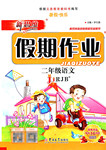题目内容
The survey about childhood in the Third World shows that the struggle for survival is long and hard. But in the rich world, children can __(1)__ from a different kind of poverty of the spirit. __(2)__, one Western country alone now sees 14 000 attempted suicides(自杀)every year by children under 15, and one child __(3)__ five needs psychiatric(心理)advice.
There are many good things about __(4)__ in the Third World. Take the close and constant relation between children and their parents, relatives and neighbours for example. In the West, the very nature of work puts distance between __(5)__ and children. But in most Third World villages mother and father do not go miles away each day to work in offices. __(6)__, the child sees mother and father, relations and neighbours working __(7)__ and often shares in that work.
A child __(8)__ in this way learns his or her role through joining in the community's __(9)__: helping to dig or build, look after animals or babies--rather than __(10)__ playing with water and sand in kindergarten, keeping pets __(11)__ playing with dolls.
These children may grow up with a less oppressive sense of space and time than the __(12)__ children. Their sense of days and time has a lot to do with the change of seasons and positions of the sun or the moon in the sky. Children in the rich world, __(13)__, are provided with a watch as one of the __(14)__ signs of growing up, so that they can __(15)__ along with their parents about being late for school times, meal times, bed times, the times of TV shows...
Third World children do not usually __(16)__ to stay indoors, still less in high-rise apartments(公寓). Instead of dangerous road,“keep off the grass”signs and“don't speak to strangers”, there is often a sense of __(17)__ to study and play. Parents can see their children outside rather than observe them __(18)__ from ten floors up.
__(19)__, twelve million children under five still die every year through hunger and disease. But childhood in the Third World is not all __(20)__.
|
(1)A.come |
B.learn |
|
C.suffer |
D.survive |
|
(2)A.As usual |
B.For instance |
|
C.In fact |
D.In other words |
|
(3)A.by |
B.in |
|
C.to |
D.under |
|
(4)A.childhood |
B.poverty |
|
C.spirit |
D.survival |
|
(5)A.adults |
B.fathers |
|
C.neighbours |
D.relatives |
|
(6)A.Anyhow |
B.However |
|
C.Instead |
D.Still |
|
(7)A.away |
B.alone |
|
C.along |
D.nearby |
|
(8)A.growing up |
B.living through |
|
C.playing |
D.working |
|
(9)A.activity |
B.life |
|
C.study |
D.work |
|
(10)A.by |
B.from |
|
C.through |
D.with |
|
(11)A.and |
B.but |
|
C.or |
D.so |
|
(12)A.Eastern |
B.good |
|
C.poor |
D.Western |
|
(13)A.at any moment |
B.at the same time |
|
C.on the other hand |
D.on the whole |
|
(14)A.easiest |
B.earliest |
|
C.happiest |
D.quickest |
|
(15)A.care |
B.fear |
|
C.hurry |
D.worry |
|
(16)A.dare |
B.expect |
|
C.have |
D.require |
|
(17)A.control |
B.danger |
|
C.disappointment |
D.freedom |
|
(18)A.anxiously |
B.eagerly |
|
C.impatiently |
D.proudly |
|
(19)A.Above all |
B.In the end |
|
C.Of course |
D.What's more |
|
(20)A.bad |
B.good |
|
C.rich |
D.poor |
解析:
|
(1) 发达国家孩子受到精神压力。(2) 本题为举例说明 for instance 例如。(3)one in five 五个当中有一个,“in”的一个用法。(4) 说明第三世界儿童的童年有很多乐趣。(5) 文中说这群孩子离父母较远。(6) 他们经常见到孩子,在附近工作。(7) 第三世界孩子的父母、邻居常在家附近工作。(8) 在他们成长的过程中,……。(9) 这些孩子融入了社区活动,A项应用复数。(10) 发达国家的孩子是通过幼儿园学习的方式成长,“通过”用 through。(11) 这几次活动且各项选择。(12) 此处指与西方发达国家的孩子相比。(13) 另一方面,相反的。(14) 最早的成长的标志。(15) 短语 care about 符合句意。(16) 在此表示他们并不是只能呆在家里,用 have to。(17) 此处表示第三世界儿童有自由学习的条件。(18) 发达国家的父母急切地关注着他们的孩子。(19) 进一步解释第三世界国家的情况。(20) 这个转折句表示承上文“……但是并不总是很差的”。 |

 学练快车道快乐假期寒假作业系列答案
学练快车道快乐假期寒假作业系列答案 新思维寒假作业系列答案
新思维寒假作业系列答案